NURSING ASSESSMENT.
VerifiedAdded on 2022/12/15
|6
|1598
|1
AI Summary
Contribute Materials
Your contribution can guide someone’s learning journey. Share your
documents today.

RUNNING HEAD: NURSING ASSESSMENT
NURSING ASSESSMENT
Name of Student
Name of University
Author note
NURSING ASSESSMENT
Name of Student
Name of University
Author note
Secure Best Marks with AI Grader
Need help grading? Try our AI Grader for instant feedback on your assignments.
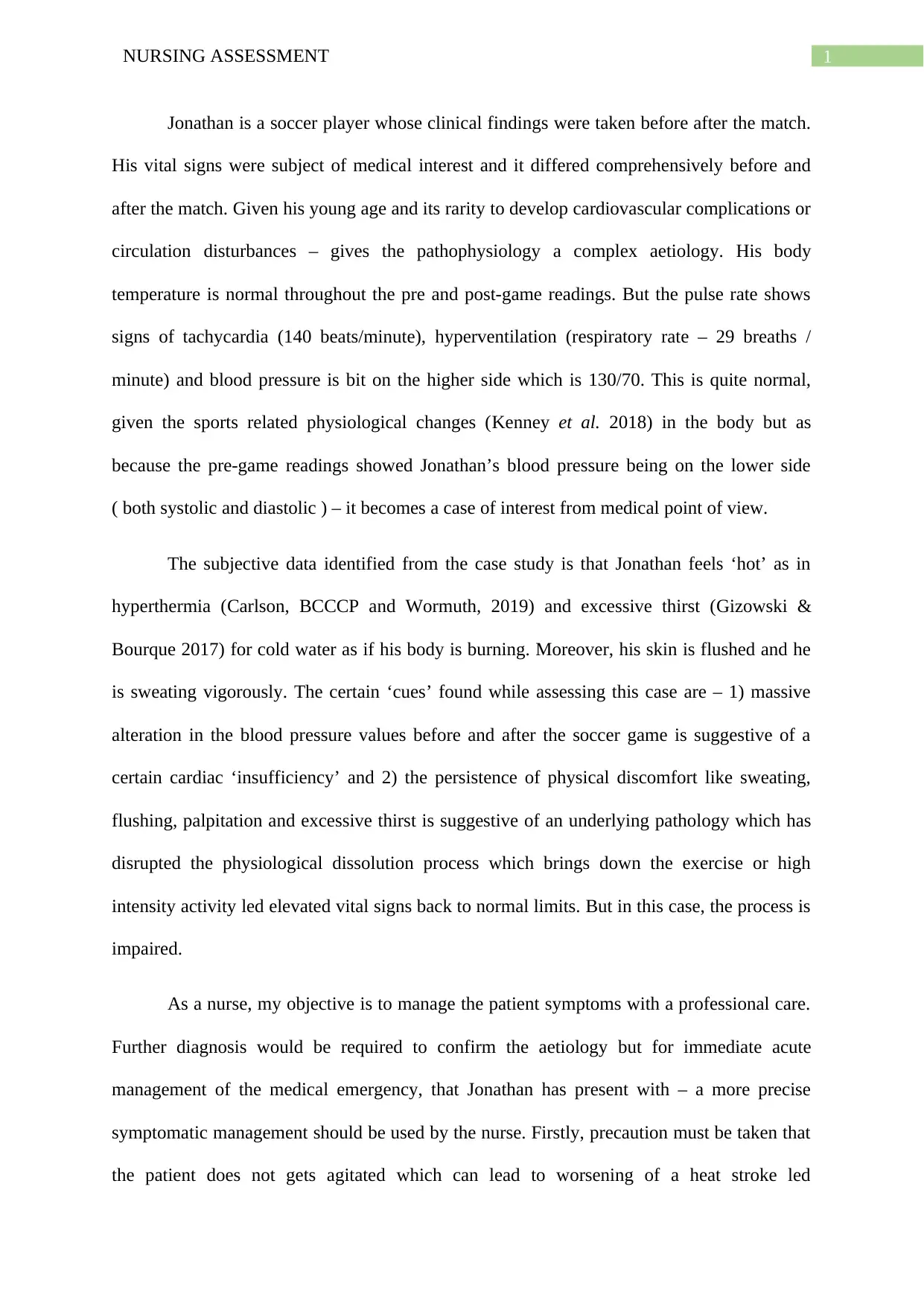
1NURSING ASSESSMENT
Jonathan is a soccer player whose clinical findings were taken before after the match.
His vital signs were subject of medical interest and it differed comprehensively before and
after the match. Given his young age and its rarity to develop cardiovascular complications or
circulation disturbances – gives the pathophysiology a complex aetiology. His body
temperature is normal throughout the pre and post-game readings. But the pulse rate shows
signs of tachycardia (140 beats/minute), hyperventilation (respiratory rate – 29 breaths /
minute) and blood pressure is bit on the higher side which is 130/70. This is quite normal,
given the sports related physiological changes (Kenney et al. 2018) in the body but as
because the pre-game readings showed Jonathan’s blood pressure being on the lower side
( both systolic and diastolic ) – it becomes a case of interest from medical point of view.
The subjective data identified from the case study is that Jonathan feels ‘hot’ as in
hyperthermia (Carlson, BCCCP and Wormuth, 2019) and excessive thirst (Gizowski &
Bourque 2017) for cold water as if his body is burning. Moreover, his skin is flushed and he
is sweating vigorously. The certain ‘cues’ found while assessing this case are – 1) massive
alteration in the blood pressure values before and after the soccer game is suggestive of a
certain cardiac ‘insufficiency’ and 2) the persistence of physical discomfort like sweating,
flushing, palpitation and excessive thirst is suggestive of an underlying pathology which has
disrupted the physiological dissolution process which brings down the exercise or high
intensity activity led elevated vital signs back to normal limits. But in this case, the process is
impaired.
As a nurse, my objective is to manage the patient symptoms with a professional care.
Further diagnosis would be required to confirm the aetiology but for immediate acute
management of the medical emergency, that Jonathan has present with – a more precise
symptomatic management should be used by the nurse. Firstly, precaution must be taken that
the patient does not gets agitated which can lead to worsening of a heat stroke led
Jonathan is a soccer player whose clinical findings were taken before after the match.
His vital signs were subject of medical interest and it differed comprehensively before and
after the match. Given his young age and its rarity to develop cardiovascular complications or
circulation disturbances – gives the pathophysiology a complex aetiology. His body
temperature is normal throughout the pre and post-game readings. But the pulse rate shows
signs of tachycardia (140 beats/minute), hyperventilation (respiratory rate – 29 breaths /
minute) and blood pressure is bit on the higher side which is 130/70. This is quite normal,
given the sports related physiological changes (Kenney et al. 2018) in the body but as
because the pre-game readings showed Jonathan’s blood pressure being on the lower side
( both systolic and diastolic ) – it becomes a case of interest from medical point of view.
The subjective data identified from the case study is that Jonathan feels ‘hot’ as in
hyperthermia (Carlson, BCCCP and Wormuth, 2019) and excessive thirst (Gizowski &
Bourque 2017) for cold water as if his body is burning. Moreover, his skin is flushed and he
is sweating vigorously. The certain ‘cues’ found while assessing this case are – 1) massive
alteration in the blood pressure values before and after the soccer game is suggestive of a
certain cardiac ‘insufficiency’ and 2) the persistence of physical discomfort like sweating,
flushing, palpitation and excessive thirst is suggestive of an underlying pathology which has
disrupted the physiological dissolution process which brings down the exercise or high
intensity activity led elevated vital signs back to normal limits. But in this case, the process is
impaired.
As a nurse, my objective is to manage the patient symptoms with a professional care.
Further diagnosis would be required to confirm the aetiology but for immediate acute
management of the medical emergency, that Jonathan has present with – a more precise
symptomatic management should be used by the nurse. Firstly, precaution must be taken that
the patient does not gets agitated which can lead to worsening of a heat stroke led
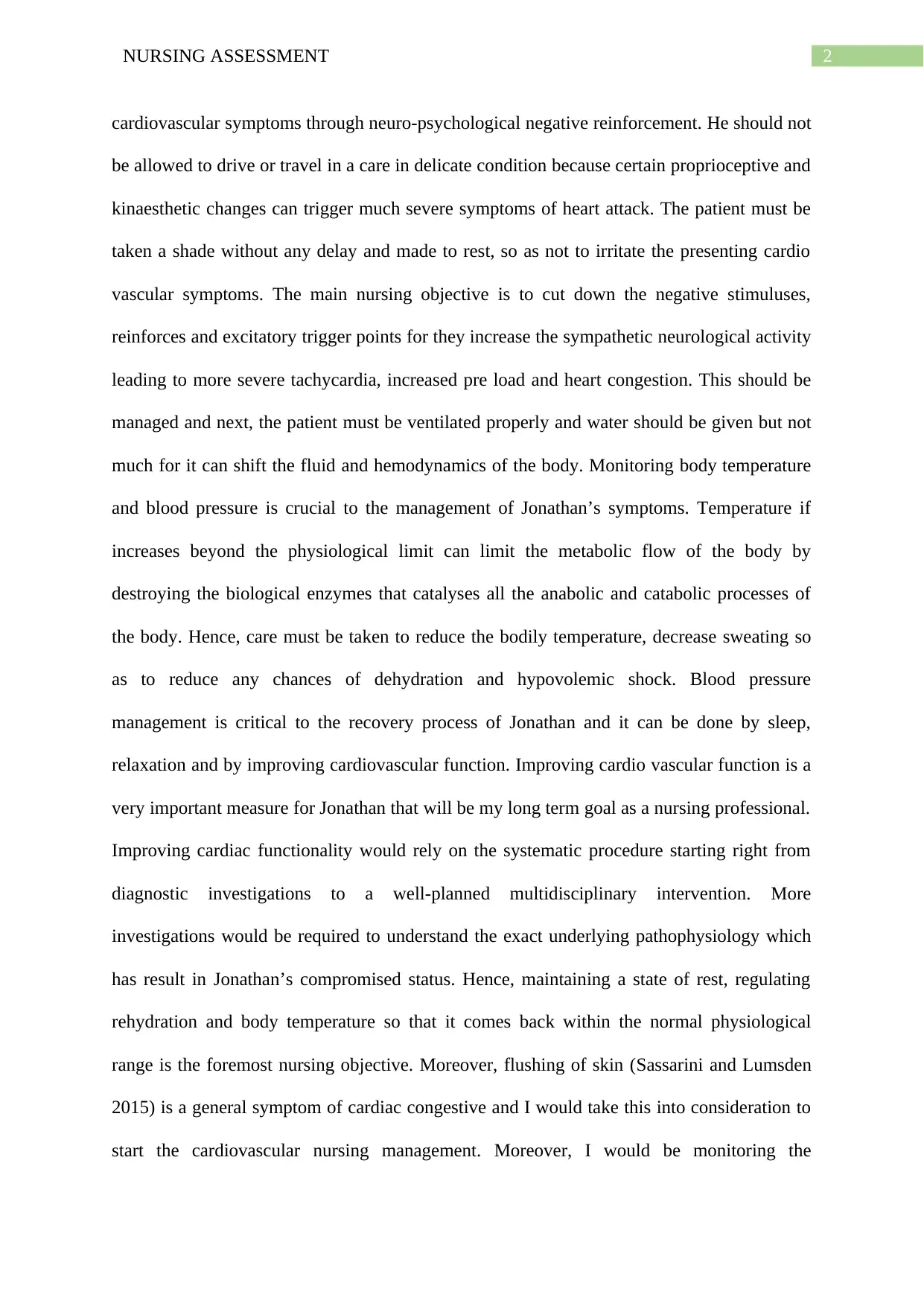
2NURSING ASSESSMENT
cardiovascular symptoms through neuro-psychological negative reinforcement. He should not
be allowed to drive or travel in a care in delicate condition because certain proprioceptive and
kinaesthetic changes can trigger much severe symptoms of heart attack. The patient must be
taken a shade without any delay and made to rest, so as not to irritate the presenting cardio
vascular symptoms. The main nursing objective is to cut down the negative stimuluses,
reinforces and excitatory trigger points for they increase the sympathetic neurological activity
leading to more severe tachycardia, increased pre load and heart congestion. This should be
managed and next, the patient must be ventilated properly and water should be given but not
much for it can shift the fluid and hemodynamics of the body. Monitoring body temperature
and blood pressure is crucial to the management of Jonathan’s symptoms. Temperature if
increases beyond the physiological limit can limit the metabolic flow of the body by
destroying the biological enzymes that catalyses all the anabolic and catabolic processes of
the body. Hence, care must be taken to reduce the bodily temperature, decrease sweating so
as to reduce any chances of dehydration and hypovolemic shock. Blood pressure
management is critical to the recovery process of Jonathan and it can be done by sleep,
relaxation and by improving cardiovascular function. Improving cardio vascular function is a
very important measure for Jonathan that will be my long term goal as a nursing professional.
Improving cardiac functionality would rely on the systematic procedure starting right from
diagnostic investigations to a well-planned multidisciplinary intervention. More
investigations would be required to understand the exact underlying pathophysiology which
has result in Jonathan’s compromised status. Hence, maintaining a state of rest, regulating
rehydration and body temperature so that it comes back within the normal physiological
range is the foremost nursing objective. Moreover, flushing of skin (Sassarini and Lumsden
2015) is a general symptom of cardiac congestive and I would take this into consideration to
start the cardiovascular nursing management. Moreover, I would be monitoring the
cardiovascular symptoms through neuro-psychological negative reinforcement. He should not
be allowed to drive or travel in a care in delicate condition because certain proprioceptive and
kinaesthetic changes can trigger much severe symptoms of heart attack. The patient must be
taken a shade without any delay and made to rest, so as not to irritate the presenting cardio
vascular symptoms. The main nursing objective is to cut down the negative stimuluses,
reinforces and excitatory trigger points for they increase the sympathetic neurological activity
leading to more severe tachycardia, increased pre load and heart congestion. This should be
managed and next, the patient must be ventilated properly and water should be given but not
much for it can shift the fluid and hemodynamics of the body. Monitoring body temperature
and blood pressure is crucial to the management of Jonathan’s symptoms. Temperature if
increases beyond the physiological limit can limit the metabolic flow of the body by
destroying the biological enzymes that catalyses all the anabolic and catabolic processes of
the body. Hence, care must be taken to reduce the bodily temperature, decrease sweating so
as to reduce any chances of dehydration and hypovolemic shock. Blood pressure
management is critical to the recovery process of Jonathan and it can be done by sleep,
relaxation and by improving cardiovascular function. Improving cardio vascular function is a
very important measure for Jonathan that will be my long term goal as a nursing professional.
Improving cardiac functionality would rely on the systematic procedure starting right from
diagnostic investigations to a well-planned multidisciplinary intervention. More
investigations would be required to understand the exact underlying pathophysiology which
has result in Jonathan’s compromised status. Hence, maintaining a state of rest, regulating
rehydration and body temperature so that it comes back within the normal physiological
range is the foremost nursing objective. Moreover, flushing of skin (Sassarini and Lumsden
2015) is a general symptom of cardiac congestive and I would take this into consideration to
start the cardiovascular nursing management. Moreover, I would be monitoring the
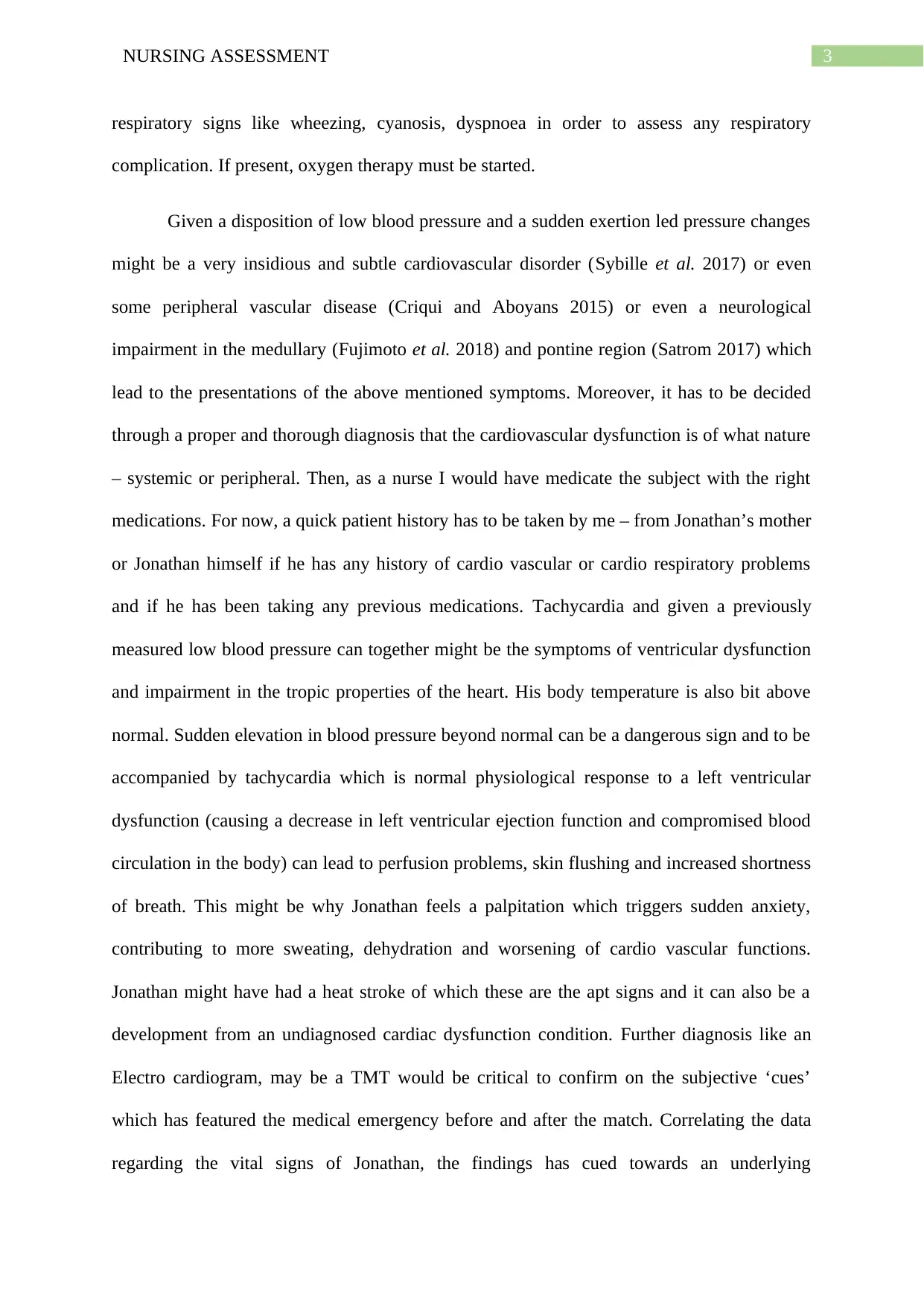
3NURSING ASSESSMENT
respiratory signs like wheezing, cyanosis, dyspnoea in order to assess any respiratory
complication. If present, oxygen therapy must be started.
Given a disposition of low blood pressure and a sudden exertion led pressure changes
might be a very insidious and subtle cardiovascular disorder (Sybille et al. 2017) or even
some peripheral vascular disease (Criqui and Aboyans 2015) or even a neurological
impairment in the medullary (Fujimoto et al. 2018) and pontine region (Satrom 2017) which
lead to the presentations of the above mentioned symptoms. Moreover, it has to be decided
through a proper and thorough diagnosis that the cardiovascular dysfunction is of what nature
– systemic or peripheral. Then, as a nurse I would have medicate the subject with the right
medications. For now, a quick patient history has to be taken by me – from Jonathan’s mother
or Jonathan himself if he has any history of cardio vascular or cardio respiratory problems
and if he has been taking any previous medications. Tachycardia and given a previously
measured low blood pressure can together might be the symptoms of ventricular dysfunction
and impairment in the tropic properties of the heart. His body temperature is also bit above
normal. Sudden elevation in blood pressure beyond normal can be a dangerous sign and to be
accompanied by tachycardia which is normal physiological response to a left ventricular
dysfunction (causing a decrease in left ventricular ejection function and compromised blood
circulation in the body) can lead to perfusion problems, skin flushing and increased shortness
of breath. This might be why Jonathan feels a palpitation which triggers sudden anxiety,
contributing to more sweating, dehydration and worsening of cardio vascular functions.
Jonathan might have had a heat stroke of which these are the apt signs and it can also be a
development from an undiagnosed cardiac dysfunction condition. Further diagnosis like an
Electro cardiogram, may be a TMT would be critical to confirm on the subjective ‘cues’
which has featured the medical emergency before and after the match. Correlating the data
regarding the vital signs of Jonathan, the findings has cued towards an underlying
respiratory signs like wheezing, cyanosis, dyspnoea in order to assess any respiratory
complication. If present, oxygen therapy must be started.
Given a disposition of low blood pressure and a sudden exertion led pressure changes
might be a very insidious and subtle cardiovascular disorder (Sybille et al. 2017) or even
some peripheral vascular disease (Criqui and Aboyans 2015) or even a neurological
impairment in the medullary (Fujimoto et al. 2018) and pontine region (Satrom 2017) which
lead to the presentations of the above mentioned symptoms. Moreover, it has to be decided
through a proper and thorough diagnosis that the cardiovascular dysfunction is of what nature
– systemic or peripheral. Then, as a nurse I would have medicate the subject with the right
medications. For now, a quick patient history has to be taken by me – from Jonathan’s mother
or Jonathan himself if he has any history of cardio vascular or cardio respiratory problems
and if he has been taking any previous medications. Tachycardia and given a previously
measured low blood pressure can together might be the symptoms of ventricular dysfunction
and impairment in the tropic properties of the heart. His body temperature is also bit above
normal. Sudden elevation in blood pressure beyond normal can be a dangerous sign and to be
accompanied by tachycardia which is normal physiological response to a left ventricular
dysfunction (causing a decrease in left ventricular ejection function and compromised blood
circulation in the body) can lead to perfusion problems, skin flushing and increased shortness
of breath. This might be why Jonathan feels a palpitation which triggers sudden anxiety,
contributing to more sweating, dehydration and worsening of cardio vascular functions.
Jonathan might have had a heat stroke of which these are the apt signs and it can also be a
development from an undiagnosed cardiac dysfunction condition. Further diagnosis like an
Electro cardiogram, may be a TMT would be critical to confirm on the subjective ‘cues’
which has featured the medical emergency before and after the match. Correlating the data
regarding the vital signs of Jonathan, the findings has cued towards an underlying
Secure Best Marks with AI Grader
Need help grading? Try our AI Grader for instant feedback on your assignments.
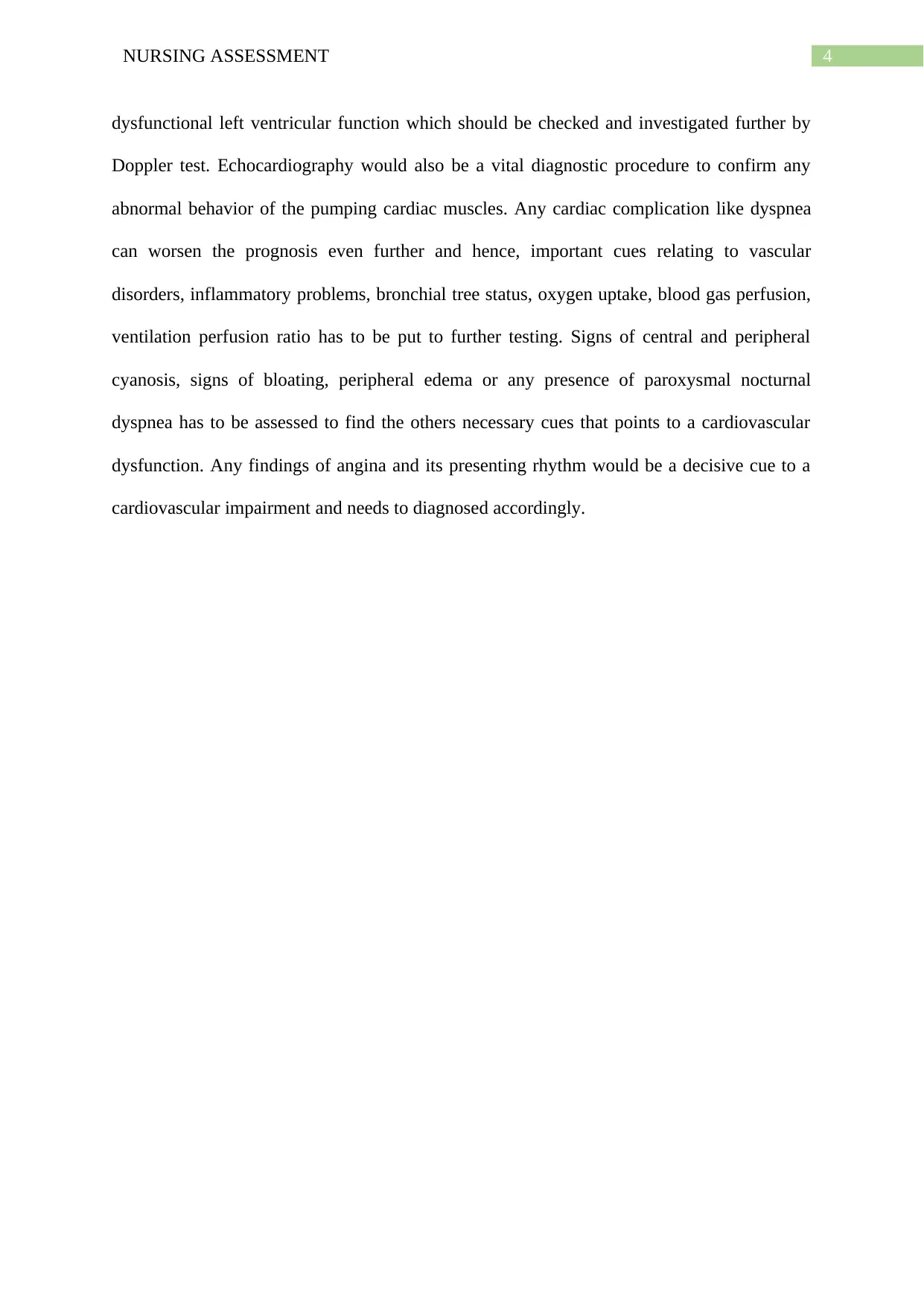
4NURSING ASSESSMENT
dysfunctional left ventricular function which should be checked and investigated further by
Doppler test. Echocardiography would also be a vital diagnostic procedure to confirm any
abnormal behavior of the pumping cardiac muscles. Any cardiac complication like dyspnea
can worsen the prognosis even further and hence, important cues relating to vascular
disorders, inflammatory problems, bronchial tree status, oxygen uptake, blood gas perfusion,
ventilation perfusion ratio has to be put to further testing. Signs of central and peripheral
cyanosis, signs of bloating, peripheral edema or any presence of paroxysmal nocturnal
dyspnea has to be assessed to find the others necessary cues that points to a cardiovascular
dysfunction. Any findings of angina and its presenting rhythm would be a decisive cue to a
cardiovascular impairment and needs to diagnosed accordingly.
dysfunctional left ventricular function which should be checked and investigated further by
Doppler test. Echocardiography would also be a vital diagnostic procedure to confirm any
abnormal behavior of the pumping cardiac muscles. Any cardiac complication like dyspnea
can worsen the prognosis even further and hence, important cues relating to vascular
disorders, inflammatory problems, bronchial tree status, oxygen uptake, blood gas perfusion,
ventilation perfusion ratio has to be put to further testing. Signs of central and peripheral
cyanosis, signs of bloating, peripheral edema or any presence of paroxysmal nocturnal
dyspnea has to be assessed to find the others necessary cues that points to a cardiovascular
dysfunction. Any findings of angina and its presenting rhythm would be a decisive cue to a
cardiovascular impairment and needs to diagnosed accordingly.
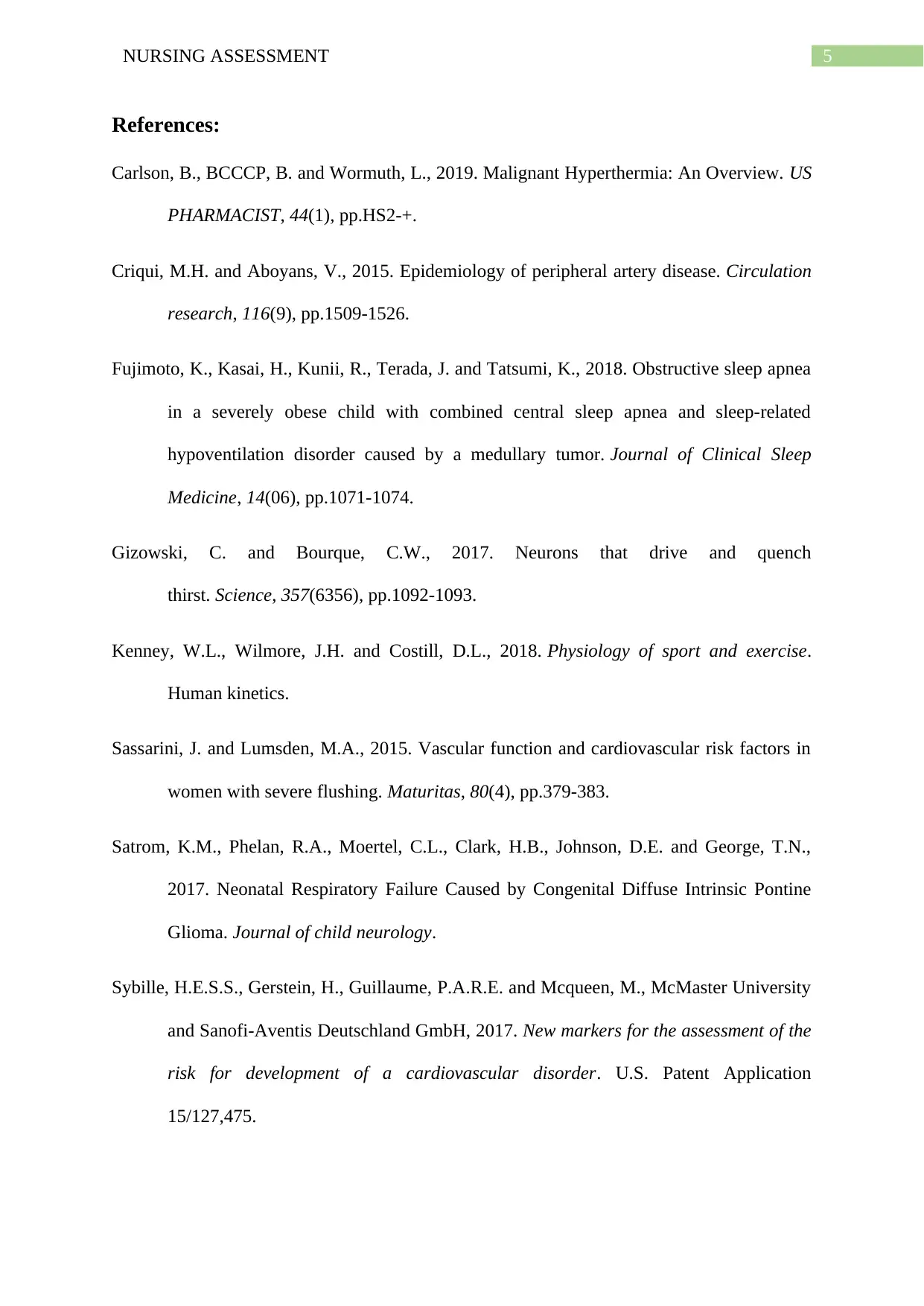
5NURSING ASSESSMENT
References:
Carlson, B., BCCCP, B. and Wormuth, L., 2019. Malignant Hyperthermia: An Overview. US
PHARMACIST, 44(1), pp.HS2-+.
Criqui, M.H. and Aboyans, V., 2015. Epidemiology of peripheral artery disease. Circulation
research, 116(9), pp.1509-1526.
Fujimoto, K., Kasai, H., Kunii, R., Terada, J. and Tatsumi, K., 2018. Obstructive sleep apnea
in a severely obese child with combined central sleep apnea and sleep-related
hypoventilation disorder caused by a medullary tumor. Journal of Clinical Sleep
Medicine, 14(06), pp.1071-1074.
Gizowski, C. and Bourque, C.W., 2017. Neurons that drive and quench
thirst. Science, 357(6356), pp.1092-1093.
Kenney, W.L., Wilmore, J.H. and Costill, D.L., 2018. Physiology of sport and exercise.
Human kinetics.
Sassarini, J. and Lumsden, M.A., 2015. Vascular function and cardiovascular risk factors in
women with severe flushing. Maturitas, 80(4), pp.379-383.
Satrom, K.M., Phelan, R.A., Moertel, C.L., Clark, H.B., Johnson, D.E. and George, T.N.,
2017. Neonatal Respiratory Failure Caused by Congenital Diffuse Intrinsic Pontine
Glioma. Journal of child neurology.
Sybille, H.E.S.S., Gerstein, H., Guillaume, P.A.R.E. and Mcqueen, M., McMaster University
and Sanofi-Aventis Deutschland GmbH, 2017. New markers for the assessment of the
risk for development of a cardiovascular disorder. U.S. Patent Application
15/127,475.
References:
Carlson, B., BCCCP, B. and Wormuth, L., 2019. Malignant Hyperthermia: An Overview. US
PHARMACIST, 44(1), pp.HS2-+.
Criqui, M.H. and Aboyans, V., 2015. Epidemiology of peripheral artery disease. Circulation
research, 116(9), pp.1509-1526.
Fujimoto, K., Kasai, H., Kunii, R., Terada, J. and Tatsumi, K., 2018. Obstructive sleep apnea
in a severely obese child with combined central sleep apnea and sleep-related
hypoventilation disorder caused by a medullary tumor. Journal of Clinical Sleep
Medicine, 14(06), pp.1071-1074.
Gizowski, C. and Bourque, C.W., 2017. Neurons that drive and quench
thirst. Science, 357(6356), pp.1092-1093.
Kenney, W.L., Wilmore, J.H. and Costill, D.L., 2018. Physiology of sport and exercise.
Human kinetics.
Sassarini, J. and Lumsden, M.A., 2015. Vascular function and cardiovascular risk factors in
women with severe flushing. Maturitas, 80(4), pp.379-383.
Satrom, K.M., Phelan, R.A., Moertel, C.L., Clark, H.B., Johnson, D.E. and George, T.N.,
2017. Neonatal Respiratory Failure Caused by Congenital Diffuse Intrinsic Pontine
Glioma. Journal of child neurology.
Sybille, H.E.S.S., Gerstein, H., Guillaume, P.A.R.E. and Mcqueen, M., McMaster University
and Sanofi-Aventis Deutschland GmbH, 2017. New markers for the assessment of the
risk for development of a cardiovascular disorder. U.S. Patent Application
15/127,475.
1 out of 6
Related Documents
Your All-in-One AI-Powered Toolkit for Academic Success.
+13062052269
info@desklib.com
Available 24*7 on WhatsApp / Email
![[object Object]](/_next/static/media/star-bottom.7253800d.svg)
Unlock your academic potential
© 2024 | Zucol Services PVT LTD | All rights reserved.





